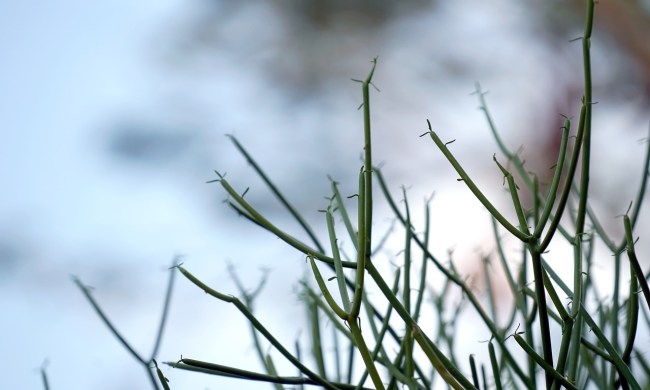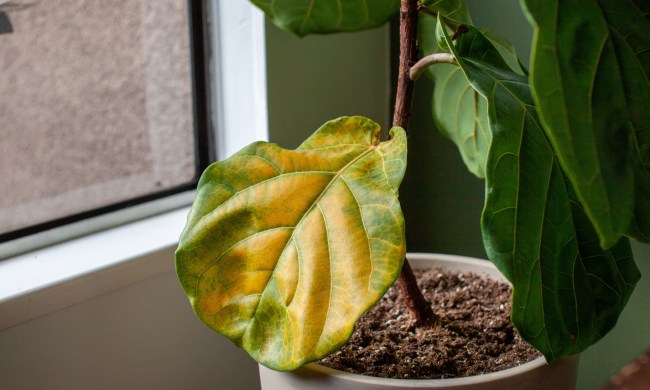Every year, we watch plants outside go dormant. The trees change color, drop their leaves, and we’re left with what appear to be dying forests blanketed in snow. But come spring, without fail, green buds start to pop up all over the place — almost as if the plants have come back to life. But do indoor plants go dormant? Are winter dormant houseplants a thing? Well, yes. Winter dormancy is part of the natural order, and houseplants are no exception. In fact, dormancy plays an important role in your plant’s life! Still, it raises a lot of questions for gardeners.
How do you know if your plant is dormant or dead? Why do plants go dormant, and can you stop it? How do you take care of a dormant plant? This guide will answer all your questions.
What’s the purpose of winter dormancy?

From April to August, plants are blooming and growing leaves like there’s no tomorrow. This is what’s known as the growing season, which, believe it or not, isn’t just a season for outdoor gardens. Like outdoor garden beds, indoor plants thrive during these months because of the warmer temperatures and longer daylight hours. There’s more time to photosynthesize, so they can produce more energy to put toward growing bigger leaves and stronger stems.
All these factors, when we look at them from the opposite end of the spectrum, are why plants experience winter dormancy. The shorter daylight hours and colder temperatures mean there’s less time during the day to photosynthesize, so plants have to use what little stored energy they have to focus on surviving the cold instead of putting out new growth. This is why you’ll often see fewer leaves being produced and weaker ones dropping off. The plant is trying to keep itself as healthy as possible, and it relies on you for a good chunk of that care.
Usually, you don’t need to do anything to get plants to go dormant. It’s part of a natural process that happens when the world cools and there isn’t as much sun. All you need to do is let things happen naturally while maintaining a new winter care routine.
How do you know if your plant is going dormant or dying?

Between falling and yellowing leaves, plants going through dormancy sure look a lot like they’re dying. So how can you tell if your plant is dying, or if it’s simply following the course of nature?
First and foremost, we recommend inspecting the roots. Dormant plants will still have healthy, growing roots, so pluck your plant up from the soil and inspect its roots. If the root system is not mushy or desiccated, there’s a good chance that your plant is simply going through a dormancy period. If you have enough foliage to work with, you could also try snapping or bending a stem. You should see moist wood or green tissue if your plant is still alive.
How to care for dormant houseplants

Caring for dormant houseplants isn’t all that different from caring for them during the growing season. The general guideline is to simply do less of it; however, there are some things you’ll want to add in or stop doing to give them the happiest winter possible.
- Water less often. Because plants aren’t growing as fast, they aren’t using up as much water. It’s recommended that during the winter months, you test the soil with your finger to see how moist it is. Water only when at least the top 2 inches are dry.
- Maintain humidity. Most plants love some level of humidity, and they hate drying out during the winter. You can help maintain a good humidity level by either getting a humidifier or grouping your plants together to create a microclimate.
- Move your plants away from drafts. Winter care may mean relocating your plants if your windows are drafty. Plants don’t like the cold, and any air coming in through cracks in the windows will potentially shock your houseplants. Ideally, they should be in an area between 65 and 75 degrees Fahrenheit, even in the colder months.
- Don’t fertilize. Plants aren’t using as many nutrients in the winter and likely won’t use up the fertilizer you give them. The excess will sit in the soil and throw off the natural balance. It’s best to only fertilize during the active growing season, as fertilizing outside of it can hurt more than help.
- Dust off the leaves. Because growth has slowed, houseplants in winter accumulate lots of dust on the leaves. The dust and dirt is, unfortunately, a perfect breeding ground for pests and diseases. Dust leaves off gently and regularly with a damp cloth to keep them clean and healthy. You should also be trimming off any dead or dying leaves.
It can take a bit for houseplants to fully come out of winter dormancy once spring arrives. To help them along, make sure they’re in an ideal growing environment and give them a bit of fertilizer to get them started.
Common houseplants that go dormant

If you’ve noticed slow growth during the colder months with a lot of your houseplants, chances are they’re experiencing some level of winter dormancy. Plants that go through this phase should be cared for, not discarded, as the full growth you know and love will return once the weather starts to warm up.
Having one or more of these houseplants in your collection will let you see what winter dormancy looks like:
- Marble queen pothos
- Chinese evergreen
- Philodendron
- Aloe vera
- Snake plant
- Fiddle-leaf fig
- Monstera deliciosa
Can you prevent a plant from going dormant?

If the idea of your plant fading over winter makes you sad, you may wonder if it’s possible to stop it from happening. It is technically possible to delay or prevent winter dormancy, although it isn’t always successful. The drop in temperature and decrease in light is what prompts plants to go dormant, so using grow lights and artificial heat sources to keep the temperature and light stable around your plant can prevent them from going dormant.
However, it’s important to remember that plants go dormant for a reason! It acts a bit like hibernation or a time of rest for many plants, and plants that naturally go dormant can suffer if they are prevented from going dormant. In short, if you don’t let your plant rest when it needs to, it can suffer from burnout!
And this is just the beginning. Whether it’s slow growth or leaf drop, most houseplants will experience some level of winter dormancy because that’s just the natural order of things. Be mindful of your plant care routine in the winter, and you’ll have no trouble keeping your plant babies alive through to the next growing season.



